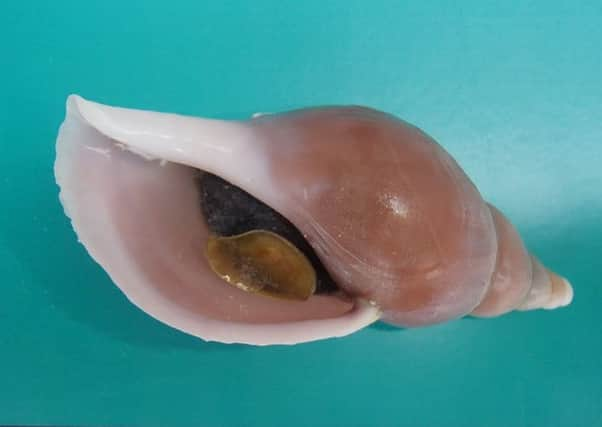Four new mollusc species discovered off Scotland


The secretive sea creatures – new species of a large sea snail, two kinds of clams and a marine worm – were found during recent trawl surveys by Marine Scotland scientists off the UK Continental Shelf in the waters of the North Atlantic, near the tiny islet of Rockall.
International experts have now confirmed that all four creatures are completely new to science, meaning they have avoided detection up to a mile below the surface during decades of underwater research around the Rockall plateau.
Advertisement
Hide AdAdvertisement
Hide AdMarine scientists also believe their remarkable discovery could point to the presence of a “cold seep” in the Atlantic Frontier near Rockall where hydrocarbon gases are released from the sea bed to create carbonate rock formations and reefs.
If confirmed, it would be the first cold seep to be discovered in the vicinity of Rockall.
Jim Drewery, from Marine Scotland Science, who led the research on the deep water invertebrates, said: “The discovery of these new species is absolutely incredible, especially when you consider that the sea snail measures a relatively large ten centimetres yet has gone undetected for decades.
“Its capture on these surveys could be due to the new techniques we are now employing at Marine Scotland Science in our research on the deep-sea floor.”
He continued: “The project we were undertaking was designed to provide advice that would help balance both commercial fishing and conservation interests in the Rockall area. The potential cold seep and its dependent community of marine life is the sort of habitat we were hoping to pick up on these surveys.”
Mr Drewery explained that the sea snail, Volutopsius scotiae, and the clam Thyasira scotiae, had been named after the research vessel MRV Scotia, while the clam Isorropodon mackayi had been named after renowned mollusc expert David W Mackay. The marine worm Antonbrunnia has not yet been officially named and is being examined at the National Museum of Wales.
The sea snails were discovered over an area approximately 80 to 260 miles west of the Hebrides at depths of up to one mile. The clams and marine worm were discovered at a single site, the location of the potential cold seep, approximately 260 miles west of the Hebrides in about three quarters of a mile depth of water.
Mr Drewery added: “I am particularly excited by the discovery of the marine worm Antonbrunnia, the first of its kind to be found in the entire Atlantic. It was discovered by international bivalve expert Dr Graham Oliver inside one of the clams he was confirming as a new species at his laboratory at the National Museum of Wales.
Advertisement
Hide AdAdvertisement
Hide Ad“We would like to thank Dr Oliver and the Belgian conchologist Koen Faussen for their tremendous contribution to this research.”
Richard Lochhead, the Scottish environment secretary, welcomed the discoveries: “Scottish waters cover an area around five times bigger than our land mass and are miles deep in places, and these hidden gems offer a fascinating glimpse of the treasures that still await discovery under the waves.”
Environmentalist Lang Banks, the director of WWF Scotland, said: “These surveys highlight that we’ve still so much to learn when it comes to life beneath the waves.”